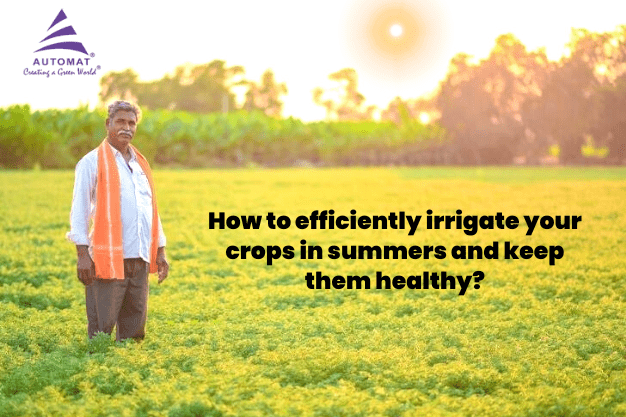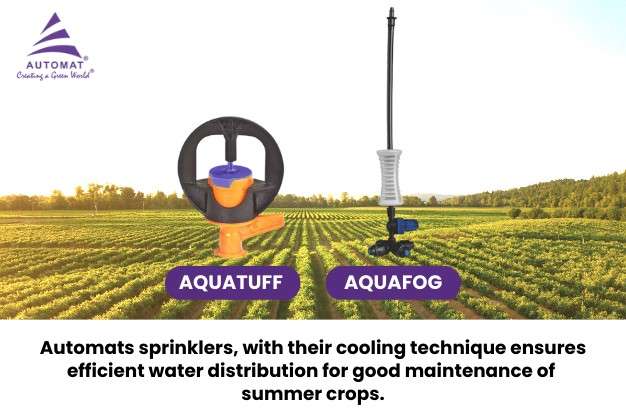This article shares insights on how to optimize the usage of water to keep crops healthy, and maintain yield even in hot weather conditions.

Irrigation systems play a critical role in the farming of summer crops, as they require a lot more water compared to those grown in the winter. It is an essential aspect of summer crop cultivation as the hot and dry weather conditions cause soil moisture to evaporate quickly which leads to water stress in plants, affecting their growth and yield.
Also, crops need a higher frequency of irrigation in summer as water also evaporates faster through the transpiration process during which there is a loss of water vapour through the stomata of plants. The loss of water vapour from the plant cools the plant down when the weather is very hot, and water from the stem and roots moves upwards or is ‘pulled’ into the leaves.
Read more: How does low-cost automation in filtration benefit irrigation systems and farmers?
Benefits of Summer Crops
-
- Summer crops provide extra income to the farmers through the optimization of resources.
- Cultivating summer crop also creates a lot of employment opportunities for casual workers.
- Cultivation of summer crops improves soil health.
- Summer crops help in reducing losses in case of an adverse Rabi season.
Summer belongs to the Zaid crops! They are sometimes known as the ‘filler’ crops between Rabi & Kharif, e.g melons of various kinds, pumpkins, and cucumber. These seasonal vegetables and fruits are mostly grown in the Gangetic belts of India also including Punjab, Gujrat, Haryana, etc. Fodder crops are examples of Zaid crops too.
Tips to Keep the Crop Healthy in Summer Season
Grow regionally
Maize, rice, sugarcane, cotton, groundnut, and turmeric are a few examples of Kharif crops. They need lots of water and hot conditions to grow well. States such as Tamil Nadu, Kerala, Maharashtra, and Assam are known for Kharif crops while rice, also a Kharif crop, is mostly grown in West Bengal, Punjab, Uttar Pradesh, Andhra Pradesh, and Bihar. Some coarse cereals are also sown in March and harvested by June end.
Nuts commonly grown in summer are Almonds, Cashews, Pistachios, Walnuts, and peanuts.
Heat-tolerant veggies
Choose vegetables and fruits that are robust and thrive in hotter climates and relatively need lesser water to grow.
If the growing season is shorter, select those vegetables that mature faster.
Common summer vegetables and fruits are Pumpkin, Cucumber, Melon, Pepper, Tomato, Bitter Rice, and Corn.
Select Short Duration Varieties
Based on the prevalent cropping system, sowing time & source of irrigation, short-duration varieties ensure that crops are not only safe from damage in the event of early summer monsoon showers but also prevent deterioration of seed quality and pre-harvest sprouting of the grains.
Summer varieties should have good initial vigour and grow profusely in the first 25–35 days so that, they are well-established before the onset of flowering.
Read more: Why Water Filtration is Necessary for Drip Irrigation System?
Proper Irrigation System
Needless to say, irrigation needs to increase as the temperature rises. Many growers turn to flood irrigation or overhead irrigation systems in the hotter months but these also use a lot of water – up to 40% more than normal irrigation requirements. Therefore, it is essential to have the right irrigation system which is well maintained and uses the minimum quantity of water while increasing the productivity of crops and the income of farmers through precision water management.
Use Pressurized Irrigation Systems in Summer Crops
Increasing the use of pressurized irrigation methods like micro sprinklers, mini sprinklers, sprinklers, and drip can help to enhance crop yield through efficient use of water as it minimizes evaporation and water runoff. It is also very suitable for all types of topography and soils and perfect for areas with limited amounts of water or with high water costs. The pressure needed by the drip/micro/mini irrigation system is between 0.7 and 1.4 kg/cm2 (10 and 20 psi).

Water deeply and less frequently
In hot weather, it is better to water crops deeply but less frequently. This allows the water to penetrate deeper into the soil, encouraging the roots to grow deeper to access moisture.
Water early in the morning or late in the evening
Irrigation of crops during the cooler parts of the day reduces water loss through evaporation and helps to keep the plants hydrated during the hottest parts of the day.
Overhead Netting
Overhead netting has become a popular method of crop cooling. The brightly-coloured netting, made from durable polypropylene, reduces sunburn and temperatures and also offers protection from birds, wind, and hail. The netting has the additional benefit of offering worker safety benefits by shielding workers’ skin from harmful sun rays. But do remember excessive shading can dampen plant productivity in areas that don’t receive consistently strong sunlight.
Monitor soil moisture
Regularly checking soil moisture levels can help you determine when to water your crops. Stick your finger into the soil to a depth of a few inches. If the soil feels dry, it’s time to water.
Consider the soil type
The type of soil can affect how much water is needed to irrigate your crops. For example, sandy soil will require more frequent watering than clay soil.
Mulching
Mulching is a superior option to keep the vegetable crop moisturized. Peat moss, coco coir, dried shredded leaves, and freshly cut fodder are all acceptable mulching materials. In addition to keeping the soil moist, mulching prevents weed growth and slows down soil erosion, reducing the need for frequent watering as it helps the soil retain moisture, and it creates cooler microenvironments at the base of the plant.
Avoid Pruning
If possible, avoid pruning plants and trees and avoid planting them during the heat of summer. If a plant has to be pruned make sure that the plant is given extra fertilizer and water after it’s been trimmed. Also, only prune on comparatively cool days when the forecast calls for cooler temperatures in the following 3 to 4 days.
Harvesting
Harvest the summer crops either late or early in the day to keep the produce fresh, crisp, and flavourful.
According to a news, the government had set a marginally higher target of 332 million tonne (MT) for foodgrain production during the 2023-24 crop year (July-June), against the estimated output of 330.5 MT in the current crop year.
To sum it up, the adoption of the simple and right method of irrigation during summer have benefits in saving water, labour, energy, leading to a reduction in farmers’ overall investment and further increasing good quality production of agricultural produce by keeping crop healthy.




